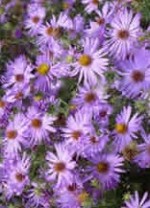 Asters are always welcome in the fall when other plants are fading, and aromatic aster is one of the last asters to bloom. A profusion of blue flowers with yellow centers are produced on bushy plants that continue blooming for 1-2 months. Although the flowers are not fragrant the crushed foliage has a pleasant aroma and is attractive all summer before the flowers appear. It spreads by creeping rhizomes. A native of rocky slopes, meadows, and savannas of eastern and central United States, aromatic aster is useful in the border as well in a meadow garden. It is an outstanding wildflower and has given rise to some cultivars such as ‘Raydon’s Favorite’ and ‘October Skies’.
Asters are always welcome in the fall when other plants are fading, and aromatic aster is one of the last asters to bloom. A profusion of blue flowers with yellow centers are produced on bushy plants that continue blooming for 1-2 months. Although the flowers are not fragrant the crushed foliage has a pleasant aroma and is attractive all summer before the flowers appear. It spreads by creeping rhizomes. A native of rocky slopes, meadows, and savannas of eastern and central United States, aromatic aster is useful in the border as well in a meadow garden. It is an outstanding wildflower and has given rise to some cultivars such as ‘Raydon’s Favorite’ and ‘October Skies’.
Type: Herbaceous perennial
Bloom: Masses of lilac blue flowers with yellow centers are produced for a month or two in fall until the first frost.
Foliage: Leaves are alternate, 2” long and ½” wide, and slightly pubescent. They have a strong aroma when crushed, giving rise to the common name of the plant
Size: 1-2’ H x 4’ W
Light: Full sun to light shade
Soil: Poor, dry well-drained; average moisture tolerated if well-drained
Fertilizer: Excessive fertilizer will cause plants to flop
Hardiness: Zones 3-8
Care: Shear in June to control height and promote bushiness
Pests and Diseases: Foliage may be susceptible to powdery mildew
Propagation: Division in winter, spring or early summer
Companion plants: Prairie Dropseed (Sporobolus heterolepis), goldenrod (Solidago spp.)
